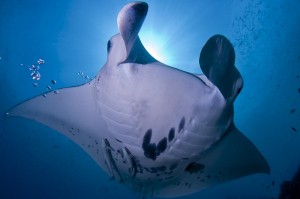Manta rays are filter feeders, preying on microscopic organisms such as copepods, mysids (small shrimp-like creatures), and the larvae of fish, lobster, and octopus.
By unrolling their two cephalic lobes and holding them at a downward angle, mantas are able to funnel huge volumes of water and the plankton it contains into their enormous mouth.
Excess water is expelled from the mouth through five pairs of gill slits on the ventral surface, a process known as ram-jet feeding. Meanwhile finger-like projections on the gill arches, known as gill rakers, strain the water and capture the food it contains.

Caphalic lobes funnel water towards the mouth. Photo courtesy Reidar Opem
When a manta’s mouth is wide open, the internal gill arches can be clearly seen. The lower jaw contains nine to twelve rows of tiny peg shaped teeth the size of pin heads. These teeth barely penetrate the skin, and are evolutionary remnants of an era when mantas hunted larger prey.
Mantas typically feed near or at the surface. Large aggregations occur in localised nutrient-rich waters within typically oligotrophic tropical waters. They can sometimes be seen swimming in repeated somersaults, remaining in a dense patch of plankton.
An adult manta may consume up to 27 kg of microscopic phytoplankton, zooplankton, copepods, and larvae in a single day.
